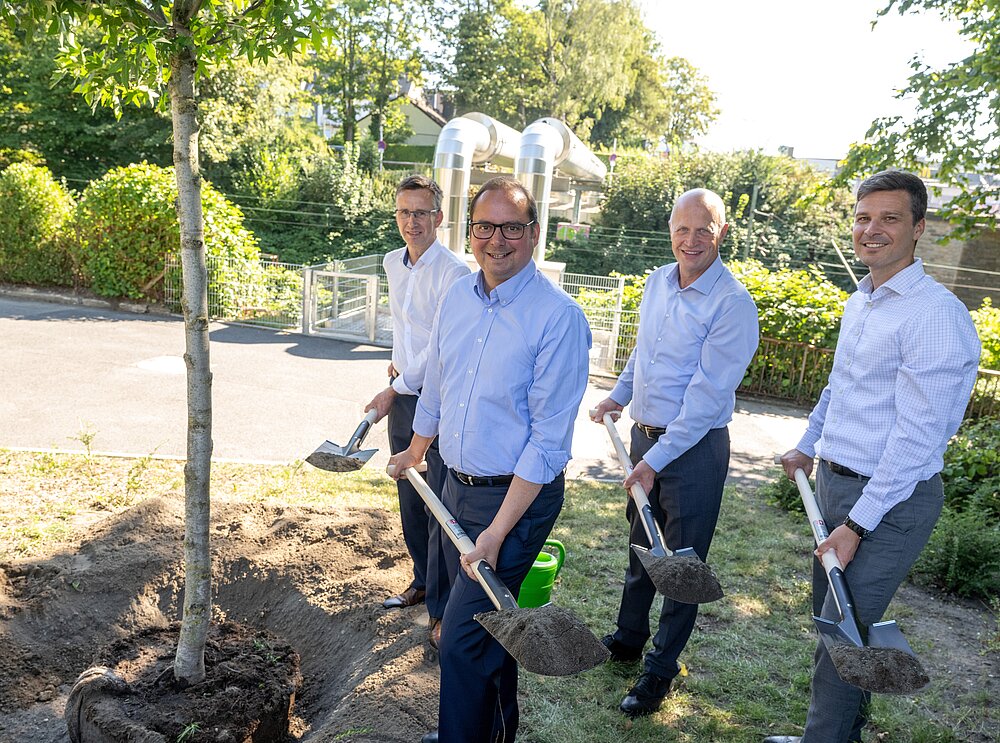District heating expansion successful
Essen. STEAG Fernwärme Essen GmbH & Co. KG, a joint venture of STEAG Fernwärme and Stadtwerke Essen AG, is celebrating the successful completion of its eastern line project in Essen: “After 1,180 days of construction work, we successfully put the district heating pipeline into operation in the spring. With the replanting of trees that has taken place in the meantime, the last remaining work has now been completed and we can take stock proudly and with satisfaction,” says Matthias Ohl, one of the two directors of STEAG Fernwärme Essen.
To mark the occasion, STEAG Fernwärme Essen hosted a small ceremony today, Thursday, August 25. In his welcoming address, Mayor Thomas Kufen praised the project as an important building block for the city of Essen on the way to more climate protection: “Thanks to the new eastern line, residents in nine further districts can now use safe, convenient and climate-friendly district heating. This major urban development project will therefore make a significant contribution to reducing emissions from heating consumption in the coming years and so also to the success of the heating transition in our city.”
Dr. Peter Schäfer, member of the Management Board of Stadtwerke Essen and also Managing Director of STEAG Fernwärme Essen GmbH & Co. KG, meanwhile emphasized the benefit to the city of this cooperation between Stadtwerke Essen and STEAG Fernwärme under the auspices of the jointly owned project company. Consequently, together with Matthias Ohl, he then also made it clear that the expansion of district heating in Essen can use the status now reached as a springboard to pick up additional speed: “After the successful crossing of the A52 motorway last year, it will now be a matter of opening up parts of the city that were previously inaccessible to climate-friendly district heating. The district heating network in Essen will continue to grow in the coming years,” say the two directors.
The eastern line in figures
In his speech, Matthias Ohl once again illustrated the technical and economic dimensions of the “Osttrasse” project: “In a construction period of 1,180 days, we used 1,350 metric tons of steel and laid 12,000 meters of piping. To do this, we excavated 60,000 cubic meters of earth and welded 2,000 seams. In the future, almost 2.4 million liters of water will flow through the newly added pipeline network to supply the people of Essen with reliable and climate-friendly heat.”
By way of comparison, the amount of steel used is roughly one fifth of the amount used to build the Eiffel Tower in Paris; the same amount of earth is excavated to build 240 single-family homes, and the water used could fill no fewer than 13,000 bathtubs. “These figures impressively show what the construction of the Osttrasse has achieved in Essen and for Essen,” says Matthias Ohl.
Investment and promotion
The financial dimension of the project is also impressive: In total, STEAG Fernwärme Essen has invested more than 20 million euros in the eastern line. 60 percent of this was publicly funded through climate protection funds from the European Union, the State of North Rhine-Westphalia and German government funds under the terms of the Combined Heat and Power Act. Further financing was provided by the local Bank im Bistum Essen and the shareholders.
Thanks to partners, supporters and employees
Michael Straus, Managing Director of STEAG Fernwärme GmbH, expressed his heartfelt thanks to the representatives of the companies, partners and authorities involved in the project, as well as to the other guests at the ceremony: “You have all played a huge part in the success of the project. We would like to say a big thank you for that!”
Finally, further thanks were extended to the employees from STEAG Fernwärme and Stadtwerke Essen, who have implemented the project over the past years: “We are very proud of the performance of our team over the past years. At the same time we are looking forward to tackling the further expansion of the Essen district heating network with this team,” said Matthias Ohl.
